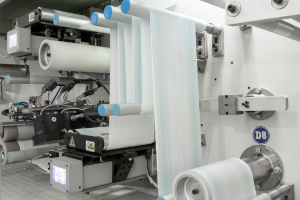Paper is one of the most revolutionary inventions of humankind. It is thanks to paper that people started developing written language. Paper is used to produce documents, bank notes and books. It is also an efficient packaging and hygienic material and a raw material for the industry. What is paper made of? What does the paper production process look like? Read our article and find out more.

How was paper invented?
The invention of paper is attributed to a Chinese official named Cai Lun. That tireless researcher spent more than ten years looking for a material that could replace bamboo and silk. After years of analysing individual stages of paper production, in the year 105 CE Lun created the world’s first provisional sheet of paper. He produced it using diluted plant fibres formed on a fabric. The Chinese invention turned out to be a great alternative to papyrus and clay tablets.
In the following centuries, the paper production process was continuously improved by Asians, Arabs and Europeans. The first paper mills in Poland were established at the end of the fifteenth century. The year 1799 was a breakthrough in the history of paper. It was then that the world’s first paper machine was invented in France. Thanks to it, long paper strips could be produced instead of single sheets.
What is paper made of?
The paper production process has evolved, and manufacturers continue to improve its composition and production methods. So what is paper made of? To make it, we need organic pulp. It is a type of water slurry containing such substances as cellulose pulp, mainly obtained from coniferous trees such as pine or spruce. Paper manufacturers also eagerly use certain types of deciduous trees, such as poplar or birch.
And what is packaging or toilet paper made of? These products are usually made of secondary raw materials such as waste paper, certain cotton fabrics as well as straw or reed. Various additives such as dyes, adhesives or coagulants also play a significant role in the papermaking process.
Stages and description of paper production
What does paper production involve? The whole process obviously begins with planting and clearing trees or collecting other materials required for making pulp. Here are the stages of paper production given step by step:
- The wood is delivered to the production plant where it is shredded into small pieces (chips).
- The chips are then ground, crushed, boiled and cleaned.
- The organic pulp undergoes processes such as bleaching or colouring and refining.
- The suspension is placed on special screens that drain the water and give the pulp a specific shape.
- The paper is then rolled, further dehydrated, pressed and cooled down.
How many phases are there in paper production? The 5 stages of paper production presented above obviously do not describe the entire production process. Depending on the intended use of the paper, it may also be cut, rolled, combined into several layers, or coated with lacquer.

How do we make a sheet of paper?
How is printer paper made? The white, smooth sheets of paper that you use every day are made from processed wood chips. During the cooking stage, the wood pulp is treated with agents such as dyes, bleaches or additives to provide the necessary strength. Manufacturers also add starch to the pulp being formed, which helps to stiffen and strengthen the sheets. After drying and shaping, the sheets are cut into any desired format using a guillotine.
The production of handmade paper
Handmade paper has been classified for centuries as what is known as a ‘noble’ paper for everyday use; how is it made? In the past, the main material used for production was shrub bast. During boiling, various ingredients were added to the pulp, including wood ash, and the resulting mixture was poured onto special screens.
How can you make your own handmade paper? Nowadays, you can make it at home. The production process is very simple and all you need is waste paper, boiling water and a cotton cloth. Pour the dissolved and ground mixture onto a fabric, mould it, and dry it. This paper production technology is therefore very simple.
How do you make new paper from waste paper?
Used paper, such as newspapers or books, is a secondary raw material that can be recycled into packaging or paper towels. How is new paper made from waste paper? The production of recycled paper looks different from the individual stages of new paper production. In recycling plants, special machines are used for shredding, cleaning and mixing with chemical additives.
How is new paper produced from recycled paper? In the technological process for recycled paper, during the processing of contaminated, foaming pulp, chemicals such as non-ionic surfactants ROKAnol® or products such as ROKAcet or ROKAfenol play a very important role. These are special agents with emulsifying, cleansing, degreasing, antistatic and defoaming properties. Additionally, other additives such as adhesives, chalk or bleaching agents (sodium hypochlorite, soda lye) are added to the pulp.
As we can see, paper production is a complex process that has been subjected to continuous improvement for centuries. Despite the development of new technologies and machines, the individual stages of producing paper from wood, such as wood processing, delamination, boiling or pressing, remained unchanged. In the case of the raw material (waste paper), the crucial role is played by speciality chemicals designed for purifying and conditioning the paper.
- https://www.britannica.com/technology/papermaking
- https://extension.okstate.edu/fact-sheets/basics-of-paper-manufacturing.html
- https://www.sciencedirect.com/topics/engineering/papermaking
- Fornalski, Zbigniew. "Zużycie i produkcja papieru i tektury w Polsce w 2012 roku na tle krajów europejskich." Przegląd Papierniczy 69, nr 9 (2013): 439-447, 449-451.